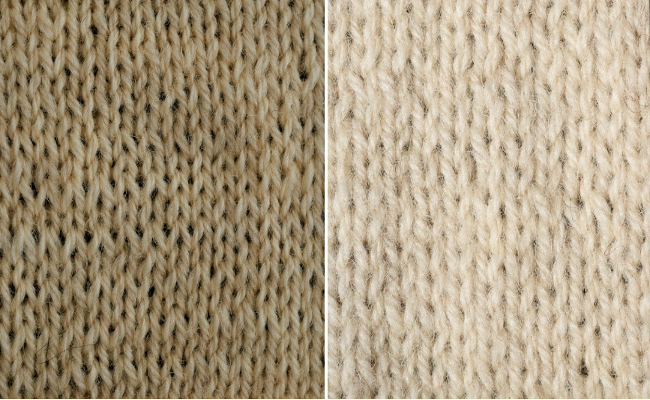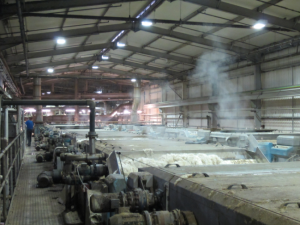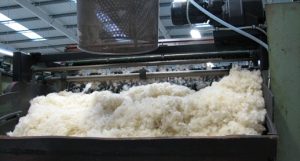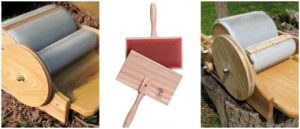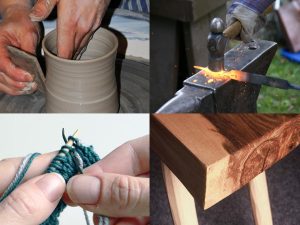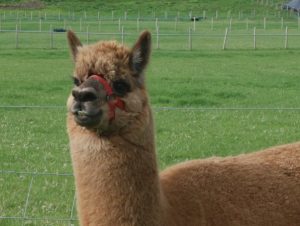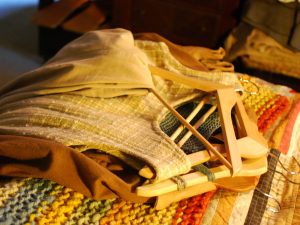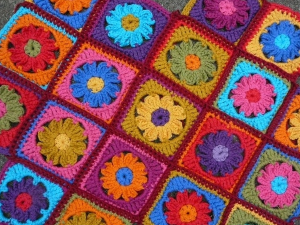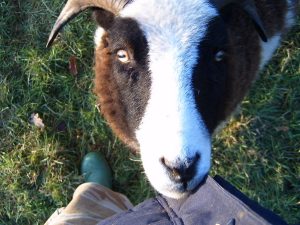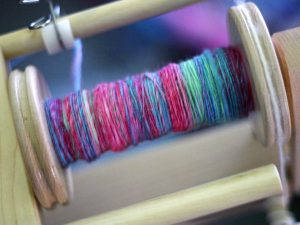Sue Blacker of The Natural Fibre Company continues The Wool Journey with the all of important question: which yarn to make?
Now comes the choice…
… between carded woollen spun and combed worsted spun yarns.
The photos below show a worsted spun Blue-faced Leicester yarn and knitted swatch (top) and a woollen spun version (bottom). There is also a downloadable information sheet about this on our website. In Part 10 we described the different methods of fibre preparation: carding for woollen-spun yarns and combing for worsted-spun yarns, so now we look at which should be chosen, for what purposes. This is something of a revision summary of earlier stages of our journey …

Credit: The Natural Fibre Company

Credit: The Natural Fibre Company
Worsted spinning is not to be confused with the US yarn type called worsted – for more information on yarn specifications there are two downloadable information sheets on our website: on yarn weights or specifications and on yarn yardage. You can also find information on knitting needles and crochet hooks for different yarns.
In choosing what yarn to make, it is important to accept and use the characteristics of the fibre, but there is also no perfect answer as it’s also a matter of choice, on handle, appearance and cost. This has been covered already in our Wool Journey in parts 2, 3, 4 and 7 in particular.
A brief summary:
- Coarse wools should be spun as thick as possible to soften the handle of a yarn, or consider making twine, rug wool or blending with softer wool
- It is debatable whether coarse wools benefit from worsted spinning unless needed for onward processing
- Medium wools will work for most purposes, but if too short cannot be worsted spun
- Fine wools will work for finer yarns and are in some ways less suitable for thicker yarns as they can be very bulky
- Fine fibres do not always make a soft yarn as their other attributes may affect the handle
- All wool will pill to some degree, woollen yarns less than worsted and coarser fibres less than fine ones
- Alpaca and mohair are smoother and less elastic, which helps handle but may cause technical problems in spinning and a yarn which sheds
- Alpaca and mohair can be added to wool yarns to improve handle or dye effects
In the end these choices are very much a matter of personal taste and aspirations – our machines will do as much as technically feasible but silk purses and sow’s ears are worth remembering!
For information specifically on 17 breeds and suitability, see Sue’s book Pure Wool which provides over 20 knitting patterns suitable for the various types of wool from these breeds as well as detailed charts at the back to show what should be an “ideal” yarn for various fibres and also the suitability of the designs for the resulting yarns.
Carding and combing compared
Carded yarns (right below) have separated and smoothed out the fibres before spinning, but they remain mingled in various directions, so that a woollen spun yarn traps air, making it light, highly insulating, fluffy and less strong than a worsted spun yarn. This slightly tangled structure much reduces the propensity to pill or shed. Woollen spun yarns are traditionally used for hand knitting, particularly colour work such as Fair Isle where a “sticky” yarn is desirable, in tweeds, blankets, throws and scarves, where warmth and insulation are wanted, and also in carpets for resilience, bulk and bounce.
Because combing takes out short fibre, woollen spinning is more suitable for shorter, downland, Shetland, Manx Loaghtan and Castlemilk Moorit wools and also for Gotland which can shed badly if worsted spun. This may also make for a better performing yarn from smooth fibres such as lustre wools, mohair or alpaca, but the process means the results will not be as soft or lustrous in appearance, so there is a trade-off between softness and other attributes.
Woollen spun yarns from our mill range from chunky to around a 3-ply weight, although it is very possible with the right equipment to spin much finer on the woollen system, as for example is done for knitwear by the specialist mills such as Gledhills or Rennie.

Credit: The Natural Fibre Company
A combed yarn (left above) has had all the fibres aligned by gilling and then refined by combing out shorter and coarser fibres before spinning, so worsted yarns are smoother, show off lustrous fibres like Wensleydale or mohair more and will superficially feel softer as they have a smooth surface. They have a higher twist, to hold the aligned fibres together and are stronger so can be spun finer for weaving purposes than woollen spun yarns. This enables them to be used in fine suitings and fine rugs, fashion scarves and shawls and for a finer or more draping hand-knit yarn. The sheen of a lustre yarn will intensify the colour when it is dyed.
Worsted spinning also suits Merino as it is very bulky when woollen spun, though sometimes the shortness of the fibres can cause yield problems. It also works for lustre yarns, and is necessary for machine knitting sock yarns and weaving yarns to go into high speed looms without snagging. At our mill we can make finer and lace-weight yarns worsted spun but not woollen spun due to our equipment range.
However, because all the fibres are aligned, they find it easier to slip out of worsted spun yarns, making them more likely to pill and shed than woollen spun yarns. There is an intermediate stage of less processed, aligned but not combed yarn, called semi-worsted, which may be more suitable for some shorter wools, alpaca, mohair and lustre wools and will yield more because of retaining the short and coarse fibres.
Apart from the decision on yarn type suited to the fibre and proposed end use, there is also an issue of yield:
- Our woollen spinning frame has 96 spindles, which must all be used for each batch. So a 15kg dry weight batch of scoured wool, which started at 20kg but lost 25% due to scouring or possibly rejecting some unsuitable fibre, has to be divided between all these spindles. It then loses a metre at each end of each spindle where it has been joined to the previous batch. This saves us half an hour threading up each batch and enables the spinning frame to work continuously, which also reduces yarn breakages on start-up. Despite these factors, we generally achieve yields of around 60% or more from original greasy input weight for woollen spun yarns.
- The same 15kg batch of scoured wool, if it is also to be combed, may lose 10-20%, depending on the fibre, so we generally achieve around 50% yields for worsted spun yarns.
- Our worsted spinning frames are two sided, so can be used with fewer spindles so there is not the same issue as with the woollen frame for yield purposes. As the sides work together though, using only one side slows production.
- Mohair and alpaca have lower grease content so can have higher yields, but also may lose more on the way through due to smoothness of the fibres, because more fall out during processing.
- Short fibre, weak fibre and second cuts will all either break or fall out of the machines and reduce yield.
- Maximum yields on worsted spinning can therefore be around 60% whereas for woollen spinning may be as high as 80%, but 50% and 60% are more normal. Some batches, for all sorts of reasons, starting with the animal and the weather, and then the response of the fibre to processing, may have much lower yields, even down to 30-40%.
So once these choices are made and all the preparations in our journey so far have been made, we can spin! The photo at the very top of this page shows worsted spun white Jacob yarn on the left and woollen spun on the right and the handle for worsted spun is considerably better than for woollen spun. There is a greater contrast between the appearance and handle of the Jacob than of the Blue-faced Leicester at the beginning of this episode, although again the handle of worsted spun is softer.
There would be less again for Wensleydale or Cotswold, as shown below, where the lustre and swatches are really very similar. So where the fibre permits worsted spinning it is often preferred, despite the additional cost, lower yield and tendency to pill more, because we all love softness best of all! Woollen spun yarns do however pay a dividend of getting softer with use and age and make much lighter garments.

Credit: The Natural Fibre Company
 About the author
About the author
As British wool spinners, The Natural Fibre Company add value by processing quantities of fleece from 20 kilograms up to over a tonne and more. As we scour, card, dye and woollen and worsted spin under one roof, we are effectively experts in all aspects of the process of turning raw fleece into high quality yarn. Most of our customers are in the UK for rare and specialist breeds.

